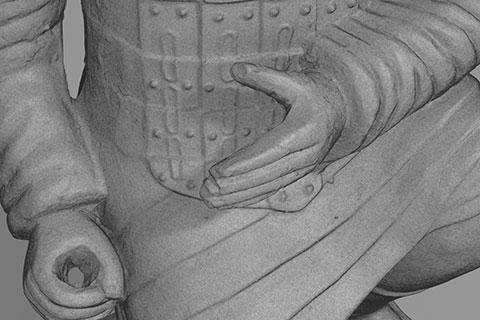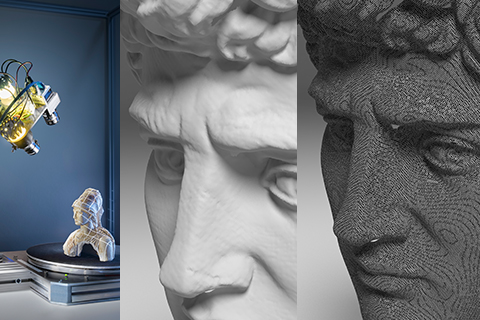J. Paul Getty Trust puts CultArm3D-P to the test
The Getty and Fraunhofer IGD Cultural Heritage Digitization Competence Center successfully collaborated in 2016/17, and have now joined forces again. Their previous project was a musical matter: they created a scaled-down 3D model of the Berlin Philharmonic concert hall. This time around, the focus is on the visual arts. The J. Paul Getty Museum, Getty Research Institute, and Getty Conservation Institute possess a broad range of objects, from full-length sculptures and busts to furniture. In this pilot project, selected objects will be digitized, as part of a long-term effort to provide digital access to the Getty’s collections..

To capture information on the Berlin Philharmonic, 360-degree laser scanners had to be positioned manually. For the latest project, the Fraunhofer IGD team, led by competence center head Pedro Santos, has developed methods for scanning sculpture-sized objects fully automatically. CultArm3D-P is a photogrammetry-based 3D scanner that makes use of a glass turntable. It can capture color-calibrated data on artifacts’ geometric shape and texture from above and below – entirely autonomously.
What’s more, the scanner can be packed up, shipped, unpacked and assembled on site extremely simply and quickly. CultArm3D-P can be divided up and placed into just four boxes and sent across the world – allowing museum exhibits and other items to be digitized without ever leaving the premises. Since April 1, the mobile CultArm3D system has been deployed in Los Angeles, where it is being evaluated by representatives of the diverse institutes and museums that make up the J. Paul Getty Trust. By April 17, the scanner will have completed its trial in the States, and will be packed up with all its accessories for the return trip across the pond.
About CultArm3D-P
CultArm3D-P is a color-calibrated autonomous scanner. Using photogrammetry, it can capture data on the geometric shape and texture of diverse objects. In contrast to traditional technologies, the scanner delivers high-resolution results, and decides for itself how to view a particular item. Based on an initial scan, sophisticated algorithms determine what further scanning positions are required. This allows CultArm3D-P to collect information on an object quickly, with a minimal number of scans – and without prior training or a CAD model. It enables the system to digitize virtually any object in 3D. The evaluated CultArm3D-P Scanner is being built to order for Friedrich-Schiller-University in Jena for their research project Cultur3D.

Further information:
- More about 3D-Scanning at Fraunhofer IGD (igd.fraunhofer.de)
- Website CultLab3D
- Website The Getty
 Fraunhofer Institute for Computer Graphics Research IGD
Fraunhofer Institute for Computer Graphics Research IGD